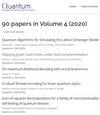驯服量子时间复杂性
IF 5.1
2区 物理与天体物理
Q1 PHYSICS, MULTIDISCIPLINARY
引用次数: 0
摘要
量子查询复杂性在组成方面有几个很好的特性。首先,有界错误量子查询算法可以通过减少错误的 "精确性"(exactness)进行组合,而不会产生对数因子。其次,通过仔细核算 "漂移性"(thriftiness),如果子程序大多运行在更便宜的输入上,则总查询复杂度会更小--与经典算法相比,量子算法的这一特性并不明显。虽然这些特性以前是通过跨度程序模型(或者说是双重对手约束)看到的,但两位作者最近的一项工作(Belovs, Yolcu 2023)表明了如何通过定义 $\textit{quantum Las Vegas query complexity}$,在不转换到跨度程序的情况下实现这些优势。另外,包括作者之一(杰弗里 2022)在内的近期研究致力于将节俭性引入更具实际意义的量子$time$复杂性设置中。在这项工作中,我们展示了如何在时间复杂性中同时实现精确性和节俭性。我们概括了杰弗里 2022 的量子子程序组成结果,因此尤其不需要减少误差。我们给出了量子查询复杂度中著名结果 $Q(f\circ g)=\mathcal{O}(Q(f)\cdot Q(g))$的时间复杂度版本,不含对数因子。我们采用了一种新颖的方法来设计量子算法,这种方法基于我们称之为 $transducers$的程序,我们认为这种方法具有很大的独立意义。跨度程序是一种完全不同的计算模型,而转换器则是量子算法的直接概括,它允许更大的透明度和控制。量子转换器自然地表征了一般状态转换,而不仅仅是决策问题;为量子行走等其他量子原语提供了非常简单的处理方法;并且非常适合时间复杂性分析。本文章由计算机程序翻译,如有差异,请以英文原文为准。
Taming Quantum Time Complexity
Quantum query complexity has several nice properties with respect to composition. First, bounded-error quantum query algorithms can be composed without incurring log factors through error reduction $exactness$. Second, through careful accounting $thriftiness$, the total query complexity is smaller if subroutines are mostly run on cheaper inputs -- a property that is much less obvious in quantum algorithms than in their classical counterparts. While these properties were previously seen through the model of span programs (alternatively, the dual adversary bound), a recent work by two of the authors (Belovs, Yolcu 2023) showed how to achieve these benefits without converting to span programs, by defining $\textit{quantum Las Vegas query complexity}$. Independently, recent works, including by one of the authors (Jeffery 2022), have worked towards bringing thriftiness to the more practically significant setting of quantum $time$ complexity.
In this work, we show how to achieve both exactness and thriftiness in the setting of time complexity. We generalize the quantum subroutine composition results of Jeffery 2022 so that, in particular, no error reduction is needed. We give a time complexity version of the well-known result in quantum query complexity, $Q(f\circ g)=\mathcal{O}(Q(f)\cdot Q(g))$, without log factors.
We achieve this by employing a novel approach to the design of quantum algorithms based on what we call $transducers$, and which we think is of large independent interest. While a span program is a completely different computational model, a transducer is a direct generalisation of a quantum algorithm, which allows for much greater transparency and control. Transducers naturally characterize general state conversion, rather than only decision problems; provide a very simple treatment of other quantum primitives such as quantum walks; and lend themselves well to time complexity analysis.
In this work, we show how to achieve both exactness and thriftiness in the setting of time complexity. We generalize the quantum subroutine composition results of Jeffery 2022 so that, in particular, no error reduction is needed. We give a time complexity version of the well-known result in quantum query complexity, $Q(f\circ g)=\mathcal{O}(Q(f)\cdot Q(g))$, without log factors.
We achieve this by employing a novel approach to the design of quantum algorithms based on what we call $transducers$, and which we think is of large independent interest. While a span program is a completely different computational model, a transducer is a direct generalisation of a quantum algorithm, which allows for much greater transparency and control. Transducers naturally characterize general state conversion, rather than only decision problems; provide a very simple treatment of other quantum primitives such as quantum walks; and lend themselves well to time complexity analysis.
求助全文
通过发布文献求助,成功后即可免费获取论文全文。
去求助
来源期刊

Quantum
Physics and Astronomy-Physics and Astronomy (miscellaneous)
CiteScore
9.20
自引率
10.90%
发文量
241
审稿时长
16 weeks
期刊介绍:
Quantum is an open-access peer-reviewed journal for quantum science and related fields. Quantum is non-profit and community-run: an effort by researchers and for researchers to make science more open and publishing more transparent and efficient.
 求助内容:
求助内容: 应助结果提醒方式:
应助结果提醒方式:


